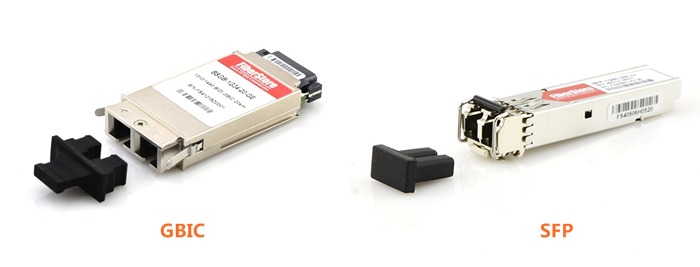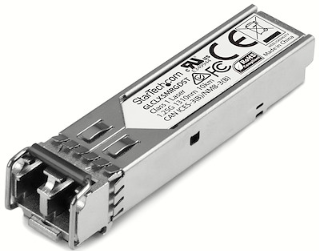GBIC vs SFP vs SFP+
GBIC
A gigabit interface converter (GBIC) is a standard for transceivers, first defined in 1995 and commonly used with Gigabit Ethernet and Fibre Channel. By offering a standard, hot swappable electrical interface, a single gigabit port can support a wide range of physical media, from copper to long-wave single-mode optical fiber, at lengths of hundreds of kilometers.
The appeal of the GBIC standard (and hot-swappable transceivers in general) in networking equipment, as opposed to fixed physical interface configurations, is its flexibility. Where multiple different optical technologies are in use, an administrator can purchase GBICs as needed, not in advance, and they can be the specific type needed for each link. This lowers the cost of the base system and gives the administrator far more flexibility. On the other hand, if a switch will mostly have one port type (especially if that port type is copper) purchasing a switch with that port type built in will be cheaper and take up less space per port.
 A GBIC is larger than a SFP
A GBIC is larger than a SFP
SFP
The SFP (Small Form-factor Pluggable), introduced in 2001, replaced the larger GBIC in most applications, and has been referred to as a Mini-GBIC by some vendors. SFP transceivers are available with a variety of transmitter and receiver specifications, allowing users to select the appropriate transceiver for each link to provide the required optical or electrical reach over the available media type (e.g. twisted pair or twinaxial copper cables, multi-mode or single-mode fiber cables). Transceivers are also designated by their transmission speed. SFP modules are commonly available in several different categories.
|
100BASE-TX SFP (Copper twisted-pair) |
1000BASE-LX SFP (SMF) |
SFP+
The SFP+ (enhanced SFP) is an enhanced version of the SFP that supports data rates up to 16 Gbit/s. The SFP+ specification was first published on 2006. SFP+ introduces direct attach for connecting two SFP+ ports without dedicated transceivers. Direct attach cables (DAC) exist in passive (up to 7 m), active (up to 15 m), and active optical (AOC, up to 100 m) variants.
10 Gbit/s SFP+ modules are exactly the same dimensions as regular SFPs, allowing the equipment manufacturer to re-use existing physical designs for 24 and 48-port switches.
SFP+ modules can be described as limiting or linear types; this describes the functionality of the inbuilt electronics. Limiting SFP+ modules include a signal amplifier to re-shape the (degraded) received signal whereas linear ones do not. Linear modules are mainly used with the low bandwidth standards such as 10GBASE-LRM; otherwise, limiting modules are preferred.
|
10GBASE-T SFP+ (Copper twisted-pair) |
|




 10GBASE-SR SFP+ (MMF)
10GBASE-SR SFP+ (MMF)